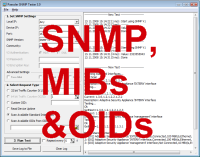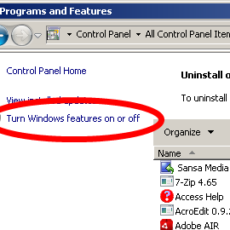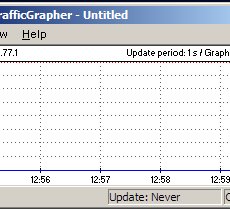Since I introduced a tiny bandwidth monitoring tool a while ago, people ask me how to find OID (Object  Identifiers) that is uniquely identify managed objects in a MIB hierarchy from the device they want to monitor. Good question, if you are not familiar with SNMP and MIBs stuff, probably you will spend hack of time to find the OIDs. Actually, there are many way to fine those, but here is simple way to find it. You need to down load some free utility that is called "SNMPtester" from www.paessler.com or click icon . Paessler.com is one of my favorite sites to introduce people look for affordable price and nice tools. See below my tips to fine OIDs, after this you can monitor any devices as long as the device is providing SNMP.
Identifiers) that is uniquely identify managed objects in a MIB hierarchy from the device they want to monitor. Good question, if you are not familiar with SNMP and MIBs stuff, probably you will spend hack of time to find the OIDs. Actually, there are many way to fine those, but here is simple way to find it. You need to down load some free utility that is called "SNMPtester" from www.paessler.com or click icon . Paessler.com is one of my favorite sites to introduce people look for affordable price and nice tools. See below my tips to fine OIDs, after this you can monitor any devices as long as the device is providing SNMP.
Check this after this article "Quick real-time bandwidth monitoring by SNMP Tool – STG"
1. Download "SNMPtester" and unzip it.
2. Click icon ![]()
3. Put below information
(1) Set SNMP Settings
Local IP : Any
Device IP: x.x.x.x (Device you want to monitor)
Port : 161 (Port currently set for SNMP)
SNMP version : v1 (currently set on your device)
Community : public (currently set on your device)
(2) Select Request Type
check " Scan Available Standard Interfaces"
(3) Run Test
4. You can see scanned list of ports and OID # on right hand side of the window. I believe you already got some idea, as soon as you see the outpput.
:
:
Found standard interfaces:
1: (001) Serial3/0,Connected,44 MBit/s,PropPointToPointSerial,
2: (002) Serial3/1,Connected,44 MBit/s,PropPointToPointSerial,
3: (003) FastEthernet1/0,Connected,100 MBit/s,Ethernet,
:
:
Testing standard interfaces…
Test 1 (1.3.6.1.2.1.2.2.1.10.1,1.3.6.1.2.1.2.2.1.16.1): in=3255521691 out=895468151
Test 2 (1.3.6.1.2.1.2.2.1.10.2,1.3.6.1.2.1.2.2.1.16.2): in=1699623616 out=901412374
Test 3 (1.3.6.1.2.1.2.2.1.10.3,1.3.6.1.2.1.2.2.1.16.3): in=1617415046 out=1038773682
:
:
As I mentioned on other article "Quick real-time bandwidth monitoring by SNMP Tool – STG"
1.3.6.1.2.1.2.2.1.10.1 – Green OID
1.3.6.1.2.1.2.2.1.16.1 – Blue OID
10 = inbound traffic (MIB OID = ifInOctets)
16 = outbound traffic (MIB OID = ifOutOctets)
Standard OID = 1.3.6.1.2.1.~
Custom OID = 1.3.6.1.4.1.~
Custom(Microsoft) = 1.3.6.1.4.1.311.1.3.1.3 (DHCP request)
Custom(Cisco Systems) = 1.3.6.1.4.1.9.9.276.1.1.1.1.11 (Output drops)
I hope this is informative for you.





 The www.ipBalance.com runs by a volunteer group with IT professionals and experts at least over 25 years of experience developing and troubleshooting IT in general. ipBalance.com is a free online resource that offers IT tutorials, tools, product reviews, and other resources to help you and your need.
The www.ipBalance.com runs by a volunteer group with IT professionals and experts at least over 25 years of experience developing and troubleshooting IT in general. ipBalance.com is a free online resource that offers IT tutorials, tools, product reviews, and other resources to help you and your need.

![[Splunk] – Basic search fields and commands logo_splunk.png](https://ipbalance.com/wp-content/uploads/2009/06/logo_splunk-100x80.png)

![[Centreon] Invalid user error, when first time login Centreon install - invalid user error message](https://ipbalance.com/wp-content/uploads/2005/06/Centreon_logo-100x58.png)